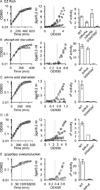Co-ordinated regulation of the extracytoplasmic stress factor, sigmaE, with other Escherichia coli sigma factors by (p)ppGpp and DksA may be achieved by specific regulation of individual holoenzymes
- PMID: 24946009
- PMCID: PMC4497380
- DOI: 10.1111/mmi.12674
Co-ordinated regulation of the extracytoplasmic stress factor, sigmaE, with other Escherichia coli sigma factors by (p)ppGpp and DksA may be achieved by specific regulation of individual holoenzymes
Abstract
The E. coli alternative sigma factor, σ(E) , transcribes genes required to maintain the cell envelope and is activated by conditions that destabilize the envelope. σ(E) is also activated during entry into stationary phase in the absence of envelope stress by the alarmone (p)ppGpp. (p)ppGpp controls a large regulatory network, reducing expression of σ(70) -dependent genes required for rapid growth and activating σ(70) -dependent and alternative sigma factor-dependent genes required for stress survival. The DksA protein often potentiates the effects of (p)ppGpp. Here we examine regulation of σ(E) by (p)ppGpp and DksA following starvation for nutrients. We find that (p)ppGpp is required for increased σ(E) activity under all conditions tested, but the requirement for DksA varies. DksA is required during amino acid starvation, but is dispensable during phosphate starvation. In contrast, regulation of σ(S) is (p)ppGpp- and DksA-dependent under all conditions tested, while negative regulation of σ(70) is DksA- but not (p)ppGpp-dependent during phosphate starvation, yet requires both factors during amino acid starvation. These findings suggest that the mechanism of transcriptional regulation by (p)ppGpp and/or DksA cannot yet be explained by a unifying model and is specific to individual promoters, individual holoenzymes, and specific starvation conditions.
© 2014 John Wiley & Sons Ltd.
Figures








Similar articles
-
DksA and ppGpp Regulate the σS Stress Response by Activating Promoters for the Small RNA DsrA and the Anti-Adapter Protein IraP.J Bacteriol. 2017 Dec 20;200(2):e00463-17. doi: 10.1128/JB.00463-17. Print 2018 Jan 15. J Bacteriol. 2017. PMID: 29061665 Free PMC article.
-
ppGpp and DksA likely regulate the activity of the extracytoplasmic stress factor sigmaE in Escherichia coli by both direct and indirect mechanisms.Mol Microbiol. 2008 Feb;67(3):619-32. doi: 10.1111/j.1365-2958.2007.06072.x. Epub 2007 Dec 12. Mol Microbiol. 2008. PMID: 18086212
-
The guanosine tetraphosphate (ppGpp) alarmone, DksA and promoter affinity for RNA polymerase in regulation of sigma-dependent transcription.Mol Microbiol. 2006 May;60(3):749-64. doi: 10.1111/j.1365-2958.2006.05129.x. Mol Microbiol. 2006. PMID: 16629675
-
Transcriptional switching in Escherichia coli during stress and starvation by modulation of sigma activity.FEMS Microbiol Rev. 2010 Sep;34(5):646-57. doi: 10.1111/j.1574-6976.2010.00223.x. Epub 2010 Apr 14. FEMS Microbiol Rev. 2010. PMID: 20491934 Review.
-
ppGpp: a global regulator in Escherichia coli.Trends Microbiol. 2005 May;13(5):236-42. doi: 10.1016/j.tim.2005.03.008. Trends Microbiol. 2005. PMID: 15866041 Review.
Cited by
-
Themes and variations in gene regulation by extracytoplasmic function (ECF) sigma factors.Curr Opin Microbiol. 2017 Apr;36:128-137. doi: 10.1016/j.mib.2017.05.004. Epub 2017 May 30. Curr Opin Microbiol. 2017. PMID: 28575802 Free PMC article. Review.
-
DksA and ppGpp Regulate the σS Stress Response by Activating Promoters for the Small RNA DsrA and the Anti-Adapter Protein IraP.J Bacteriol. 2017 Dec 20;200(2):e00463-17. doi: 10.1128/JB.00463-17. Print 2018 Jan 15. J Bacteriol. 2017. PMID: 29061665 Free PMC article.
-
The dual role of DksA protein in the regulation of Escherichia coli pArgX promoter.Nucleic Acids Res. 2016 Dec 1;44(21):10316-10325. doi: 10.1093/nar/gkw912. Epub 2016 Oct 7. Nucleic Acids Res. 2016. PMID: 27915292 Free PMC article.
-
Global Regulation by CsrA and Its RNA Antagonists.Microbiol Spectr. 2018 Mar;6(2):10.1128/microbiolspec.rwr-0009-2017. doi: 10.1128/microbiolspec.RWR-0009-2017. Microbiol Spectr. 2018. PMID: 29573256 Free PMC article. Review.
-
Circuitry Linking the Global Csr- and σE-Dependent Cell Envelope Stress Response Systems.J Bacteriol. 2017 Oct 31;199(23):e00484-17. doi: 10.1128/JB.00484-17. Print 2017 Dec 1. J Bacteriol. 2017. PMID: 28924029 Free PMC article.
References
-
- Barchinger SE, Ades SE. Regulated proteolysis: control of the Escherichia coli σ(E)-dependent cell envelope stress response. Subcell Biochem. 2013;66:129–160. - PubMed
Publication types
MeSH terms
Substances
Grants and funding
LinkOut - more resources
Full Text Sources
Other Literature Sources
Molecular Biology Databases

